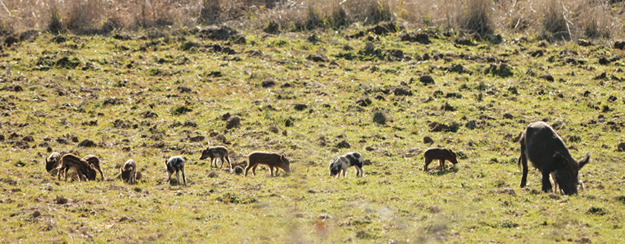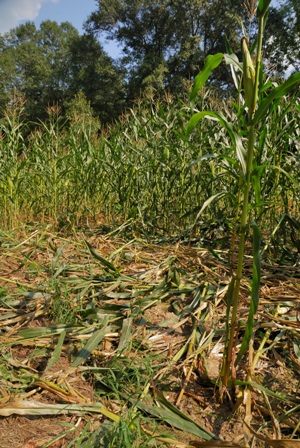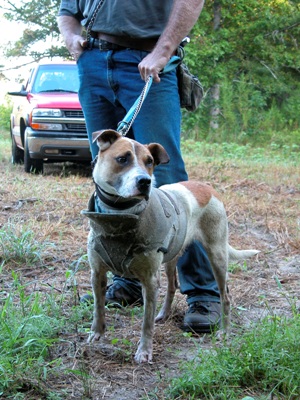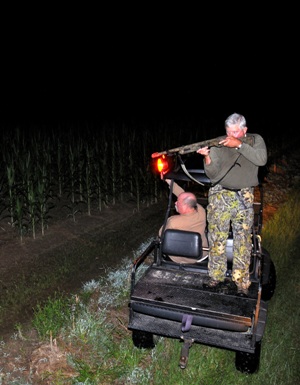Look Out, if you don’t have Hogs, They’re Coming
By Ron Jolly

I am a very lucky man. I am one of the few who have spent their life making a living in the outdoors. Photographing, videotaping and hunting wild animals give one a unique perspective and deep respect for wildlife. More than 20 years later I now find myself a lot less anxious to pull the trigger.
During my lifetime I have seen the white-tailed deer and wild turkey brought back to numbers that I could only imagine as youngster. I have seen ducks, pheasants and elk benefit and expand their range due to efforts of conservation-minded organizations and agencies.
Five years ago my wife Tes and I adopted the principles of Quality Deer Management and applied them to our small east-central Alabama farm. We spend most of our spare time and "play" money implementing these principles. The results have been dramatic. We are seeing and harvesting bigger, older bucks, more turkeys nest and rear poults on the farm, enhanced natural forage and browse attracts a variety of game animals and the improved cover helps hold them on the farm and surrounding areas.
Neighbors to our west, south and east have adopted similar principles and together we form a fair-sized cooperative. The old adage, “plant it and they will come” has never been truer. Corn, soybeans, lab-lab, clover, cereal grains, brassicas and even peanuts comprise the smorgasbord of food sources available throughout the year to the local wildlife.
The Invasion
The first indication of wild hogs on our farm came in the summer of 2004. One sow with small pigs was spotted in a field planted in chufa. The sow was killed and the pigs disappeared. Rumor was a club member released several feral pigs on a hunt club three miles south of our farm in 2002.
 In the summer of 2005 another large hog began hitting our cornfields. We consulted an Alabama Department of Conservation and Natural Resources' Enforcement officer who issued a depredation permit. This allowed us to hunt hogs at night. All efforts were unsuccessful. That single hog destroyed a lot of corn before abandoning the property in September. The same year our neighbor to the south dropped by to inform us his supplemental deer-feeding program was a huge success. Between April 30 and the first of September “deer” had consumed twice the amount of soybeans from his free-choice feeders as the year before. When he mentioned one feeder had been turned over my father-in-law, Ned, asked was he sure that only deer were eating the soybeans. He did not know the answer but a short recon trip revealed as much hog sign at the feeders as deer sign.
In the summer of 2005 another large hog began hitting our cornfields. We consulted an Alabama Department of Conservation and Natural Resources' Enforcement officer who issued a depredation permit. This allowed us to hunt hogs at night. All efforts were unsuccessful. That single hog destroyed a lot of corn before abandoning the property in September. The same year our neighbor to the south dropped by to inform us his supplemental deer-feeding program was a huge success. Between April 30 and the first of September “deer” had consumed twice the amount of soybeans from his free-choice feeders as the year before. When he mentioned one feeder had been turned over my father-in-law, Ned, asked was he sure that only deer were eating the soybeans. He did not know the answer but a short recon trip revealed as much hog sign at the feeders as deer sign.
A corral trap was built the next day near the feeder with the most hog sign. Two weeks later 23 hogs had been caught in the trap. In 2006 and 2007 a single hog raided our corn. Both years we secured a depredation permit and made all efforts to kill the raider with no success.
In 2008 a single boar began trashing a standing cornfield in late July. Trail camera photos solved the mystery of when and where he entered the field. Tes used a climbing tree stand and shot him on same trail leading to the corn. At last, meat for the freezer!
Looking back, I feel certain the trapping success on our neighbor’s delayed the inevitable. In 2009 the invasion began in earnest. The property to the south was sold and the trapping program abandoned. In July that year we began getting trail camera photos of two large boars using a mineral lick. I killed them as they left a standing cornfield late one morning. One week later trail cameras recorded a sounder of three sows and more than a dozen pigs at two different mineral licks. The cornfields were being trashed! In all, we killed a total of eight hogs that summer. More meat for the freezer but we lost one-fourth of ten acres of corn.
In 2010 the invasion intensified. Trail cameras caught images of hogs almost on a nightly basis. We killed 10 hogs that summer in and around the cornfields. We built a corral trap with a guillotine door. We did not catch a single hog in it and lost one-third of our corn.
Hog Explosion
Chris Jaworowski, a wildlife biologist with the Alabama Department of Conservation and Natural Resources Wildlife Section has been on the front lines dealing with feral hogs in Alabama. “Feral hogs are sexually mature at six months old,” says Jaworowski. “They have two litters of pigs per year and three within 14 months. Litters can have 2 to 14 pigs but average 6 to 8 pigs. If you start with two boars and two sows the numbers are staggering! Assuming a 50/50 sex ratio and six pigs per litter you will average three sows per litter. If left unchecked and there is no natural mortality those original four hogs will be responsible for 16,000 hogs in three years!”
“If you want to control hogs on your property you must realize what you are up against,” said Jaworowski. “You are dealing with an animal that is not supposed to be on your land. You have to remove them any way possible every chance you get. You have to adopt the attitude that all hogs, large and small, have to go!”
 The War
The War
At the beginning of this story I mentioned the unique perspective I feel I have after years of video-taping, photographing and hunting. I also mentioned the respect I have for all wildlife. I am comfortable with where I am in life and my approach to managing our land for wildlife. Feral hogs changed all that!
Hogs are not like deer, turkeys, rabbits, squirrels or any native game animal. They are invaders! They are destructive! Hogs occupy property and totally consume available food. They root the land and leave fields looking as if they have been carpet bombed! Hogs are relentless in their breeding, feeding and destruction of habitat. When feral hogs invade your property you have two choices. You can do nothing and suffer the consequences or you can kill the hogs. We chose to fight for our land and the native wildlife.
I can’t tell you exactly what hardened me toward feral hogs. Maybe it was the first time I broke a disk axle trying to level a field rooted up by hogs. Maybe it was watching a beautiful water hole turned into muddy slop. Maybe it was the third time I planted chufa only to discover it rooted up, again! I know seeing an acre of corn lying on the ground half-consumed played a part. Forty straight nights patrolling cornfields in summer heat and humidity probably contributed. Calling the loss of half of our corn a victory was a bitter pill.
All the above happened during the summer of 2011. We knew it was coming. Tes and I purchased an additional six Primos trail cameras and placed them on trails and mineral licks. Hogs do not live on our property. They come when summer crops planted for deer and turkey begin to mature. They inhabit the swamps and creek drainages to our south, west and east.
Beginning in June the cameras recorded image after image of hogs using our property on a nightly basis. In July the corn began setting on ears and within a week we had lost almost an acre.
One camera revealed a large boar entering a cornfield on the same trail after dark. Tes and I set two climbing treestands near the trail being used. Just before dark we climbed armed with shotguns loaded with buckshot. Two hours passed and still no hog. In the moonlight I saw a large deer in front of our stands. I pulled a Primos Bloodhunter light out of my pack and clicked on the red beam. To my surprise the deer did not seem to notice the light. At 3:00 a.m. the big boar entered the field. I put the red light on him and Tes put him down. He never noticed the red light.
 The fact that hogs did not spook from red light was a real revelation. We began stalking fields at night using the Bloodhunter lights. We soon learned the lights were effective but awkward. We needed lights that mounted on our shotguns. Online searches for red lights for hunting hogs led us to Elusive Wildlife Technologies. This company had what we needed. We purchased two XLR 100 Kill Lights with red LED’s. These lights mount on the gun barrel and effectively illuminate out to 100 yards.
The fact that hogs did not spook from red light was a real revelation. We began stalking fields at night using the Bloodhunter lights. We soon learned the lights were effective but awkward. We needed lights that mounted on our shotguns. Online searches for red lights for hunting hogs led us to Elusive Wildlife Technologies. This company had what we needed. We purchased two XLR 100 Kill Lights with red LED’s. These lights mount on the gun barrel and effectively illuminate out to 100 yards.
With the new lights in hand we adjusted our strategy by approaching fields from downwind on a HuntVe electric cart. As we moved from one field to another we used a spot light fitted with a red lens cap to light the way and scan the fields. Once near a field we sat in the dark and listened for the sounds of hogs trashing corn. When we heard hogs in the corn we dismounted the cart and approached on foot. Many times we found ourselves within 20 yards of hogs but could not see them in the corn. To eliminate that problem I mowed lanes across the fields at 75 yard intervals. These became killing lanes.
By September Tes and I were exhausted. Every night we patrolled the cornfields. Most nights we encountered hogs and many nights we killed them. Some nights we made three trips around the fields. In all we shot over 30 hogs in the corn. Some we butchered, some we gave away, many were hauled to a large hole where we dumped them to feed scavengers. What else can you do with that many hogs in summer heat? It went against everything we believe about utilizing what the land produces but there was no other choice.
Finally, in mid-September the war came to an end. Hogs just stopped coming to the corn. We were able to save half the 10 acres of corn. It may be that they found other food or maybe we put enough pressure on them to move them away.
Battle Strategies
The first thing you must learn about feral hogs is that they are relentless - relentless in their breeding, relentless in their feeding and relentless in habitat destruction. To deal with them effectively you must be relentless as well. You have to kill them to remove them from the landscape. As I write this story there are no hogs on our property. I know this because we scout for sign regularly. We keep trail cameras operational on all the likely places to monitor for hogs.
Is the war won? No! We have trapped and killed 36 hogs in May and June on the neighbor’s property to our west. The neighbor to our south uses dogs to fight the invaders. His dogs have caught over 100 hogs since February. All hogs were dispatched where they were caught. He has shot over 50 more hogs in addition. That means almost 200 hogs have been killed on two neighboring properties that total less than 4,000 acres! Tes and I are braced for the onslaught in July when our corn begins to ripen. We have planted our fields so hogs will have to cross open ground to reach the corn and cross it again to reach cover. I will cut shooting lanes when hogs hit the first field. We purchased more Kill Lights and enrolled two neighbors in our fight in hopes of adding more pressure.
Close
It is hard to write a conclusion for this story since it is still developing. The Editor in Chief has asked me to write a follow-up for the next issue. In it I will be able to tell you the how our corn fared the summer hog invasion. I'll update you on our effort to become more efficient at killing the invaders and how our cooperative has expanded to more neighbors.
My hope is that after reading this story you will be more aware of the real threat you, your land and native wildlife face by the alarming expansion of feral hogs. Maybe there will be a tactic that helps you when you face the threat because if drastic measures are not taken you will face it. I hope this story educates some good-intentioned outdoors-people who would otherwise release feral hogs into territory where they have not spread.
Tes and I adopted a motto during last summer’s ordeal—“If they stay, they gotta pay!” For now the battle against feral hogs is an ongoing effort. It is hot, dirty, hard work. We continue to learn ways that make the job a little easier and our efforts more efficient. Is it worth it? Yes! We have no choice. We like our land the way it is. We like what we have been able to accomplish with our deer and turkeys. Hogs are like cancer—they just keep coming back.



























